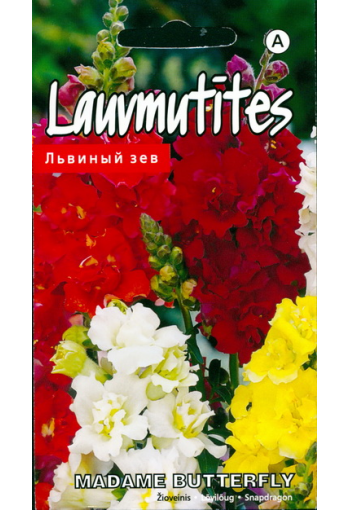Abundant bloom!
Plant height 60-75 cm. Flower diameter 4 cm.
This profusely flowering snapdragon with exotic shades will give its zest to the garden decoration.
Among the many - this mixture stands out for its height and amazing density of inflorescences. Blooming throughout the summer, a bright group of cylinders looks just great, which allows it to be used not only for landscaping, but also for cutting (both in open ground and in greenhouses).
Sowing: in protected ground - all year round, for summer flowering - in March for seedlings. Seeds are placed on the surface of moist soil, moistened from a sprayer, covered with glass (film). Seedlings appear on the 10-14th day. Dive a month after the emergence of shoots. Hardened seedlings are planted in the ground in the second half of May, maintaining a distance between plants of 20-30 cm.
Care: prefers sunny places with well-fertilized, loamy soil. Watering is done when the soil dries out. Every two weeks it is recommended to feed the plants with a solution of complex mineral fertilizer. For longer flowering, faded flower stalks must be removed.
Flowering: June - October. The duration of flowering of a flower is up to 12 days, and the whole plant - up to 4 months.

Snapdragon, Antirrhinum majus.
* Propagated snapdragon seeds and cuttings.
Snapdragon seeds remain viable for several years. In warm regions, antirrhinum can be sown directly into the ground (seedlings appear after 2.5-3 weeks and tolerate a slight cold snap), and in regions with a long spring, it is better to grow seedlings to prolong flowering.
Significantly extending the flowering time of snapdragons allows earlier cultivation of seedlings - then, soon after planting the soil (often already with buds), while still small bushes bloom their first flowers.
Early sowing of snapdragon seeds for seedlings is carried out in early March. For sowing, it is better to take a bowl with a height of at least 10 cm, always with drainage holes. Coarse-grained sand is poured into the bottom of the bowl as drainage; the bowl is filled with moist compost soil with the addition of sand (snapdragon does not grow well on peat) and the surface is compacted and levelled, sprayed with a spray bottle. Small antirrhinum seeds can be mixed with sand for a more sparse and even distribution of seeds randomly over the surface of the substrate.
After sowing, the seeds are sprinkled with a thin layer of the substrate and sprayed with a fine-dispersed spray gun for better contact of the seeds with the soil, and cover the bowl with glass crops. Every day, the glass is removed, the condensate is wiped and the crops are ventilated, and the soil is slightly moistened as needed.
Snapdragon seeds germinate for a relatively long time: under optimal conditions (temperature about 23 degrees, moderate humidity of the substrate), snapdragon shoots appear after about 2 weeks. When the first shoots appear, the bowl is immediately placed in a very bright (but not sunny) place - otherwise, the seedlings quickly stretch out. After a few days, after the appearance of mass seedlings, the glass can be removed.
Snapdragon seedlings develop rather slowly at first and do not tolerate excess moisture (it is advisable to water them carefully in the morning). If "fallen" seedlings are seen among the seedlings, in order to avoid rotting, immediately remove them with tweezers and sprinkle the soil with a thin layer of clean (washed, calcined and cooled) sand or powder with crushed charcoal (it can also be activated - "pharmacy").
Snapdragon seedlings, after the appearance of 1-2 true leaves, dive into a box - the less often, the better for good lighting of the bushes. You can pick the seedlings one at a time into small individual pots, or into a medium pot - three seedlings.
Snapdragon seedlings tolerate a neat pick well and take root quickly; after picking, they need to be kept in a bright place but covered from the sun. Seedlings that have begun to grow after picking can begin to gradually accustom (on days with variable cloudiness) to the direct sun. Seedlings of snapdragons are put on the windowsill of a glazed loggia (southwest orientation) and the window is slightly opened for fresh cool air to enter - the bushes undergo good hardening before planting in the ground.
The central shoot of grown seedlings, which has reached a height of about 8 cm, must be pinched over the 4-5th pair of leaves for good tillering. Under favourable conditions, snapdragon seedlings actively grow in width after pinching (then the side shoots are also pinched).
Planting snapdragon seedlings in the middle lane is usually carried out in May-early June. Hardened seedlings are able to endure small short-term frosts in spring.
Giant varieties of antirrhinum are planted at a distance of 50 cm from each other, tall - about 40 cm, medium - about 30 cm, undersized - about 20 cm, dwarf - about 15 cm. Giant and tall varieties of snapdragons require a garter - otherwise, they may be knocked down by the wind. Snapdragon, after good rooting, begins to grow and develop very actively, quickly turning into a profusely flowering bush.
Particularly admired are dwarf and undersized (potted, carpet, curb) varieties and hybrids of snapdragons with short peduncles: bushes planted nearby grow well in width and close, forming dense multi-coloured "pillows".
Bright colour spots sometimes cover the green foliage, forming a continuous flower carpet. At the same time, the flowers of dwarf and undersized varieties of antirrhinum are very large, which is surprising compared to the small height of plants.
Under favourable conditions for growth, you can sow and cut snapdragons all year round, which is what professionals in greenhouses do. Amateur flower growers carry out spring cuttings of antirrhinum. For this, the mother plants from which the cuttings are taken are stored in the winter. The best specimens are selected as queen cells, in August they are transplanted into pots. In winter, snapdragon queen cells are kept in a very bright, cool room with a temperature of about +7 degrees. In March-April, young shoots begin to grow in the queen cells, which are used for grafting and rooting. The cuttings are cared for in the same way as seedlings.
In the case of cultivation under adverse weather conditions, the antirrhinum may develop diseases. When evening watering the bushes from above or prolonged rains near snapdragons, the likelihood of rust increases (red spots about 1.5 mm in size cover the entire plant). Antirrhinum also has septoria blight (grey spots with yellow rims and black dots appear on the leaves) and root rot (the leaves turn yellow, the stem rots and the plant dies). Sick specimens must be immediately removed from the plantings and burned so that the spores of the fungus do not spread from them to healthy bushes. Plantings of snapdragons in which there were infected plants are sprayed with antifungal drugs.
* If you prune flowering snapdragon plants and feed them with a complex fertilizer, they will bloom again and remain bright until the frost.











